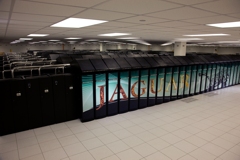
NVIDIA ha annunciato oggi che Oak Ridge National Laboratory (ORNL), che gestisce la principale struttura mondiale di computing scientifico per il Department of Energy degli USA, intende realizzare un nuovo e rivoluzionario supercomputer, "Titan", basato su GPU NVIDIA Tesla. Grazie al potenziale di offrire oltre 20 petaflop di prestazioni di picco, Titan, un supercomputer Cray XK6, sarebbe oltre due volte più veloce e tre volte più efficiente dal punto di vista energetico dell’attuale primatista tra i supercomputer, il K Computer, che si trova in Giappone.
Titan sarà uno strumento davvero rivoluzionario per gli scienziati che potranno sfruttare la massiccia potenza di elaborazione in parallelo delle GPU per la ricerca e le scoperte scientifiche. Il sistema verrà usato per la ricerca in quasi tutti i campi dello scibile umano, fra cui spiccano le scienze dei materiali, le tecnologie per la produzione di energia, la medicina, le scienze geologiche e altri ancora.
"Tutte le aree della scienza riceveranno nuovo impulso da questo sostanziale aumento della potenza di calcolo che apre le porte a nuove scoperte sinora del tutto impossibili", ha dichiarato Jeff Nichols, Associate Laboratory Director per Computing e Computational Sciences all'Oak Ridge National Laboratory. "Titan verrà usato per una varietà di progetti di ricerca davvero cruciali, fra cui lo sviluppo di biocarburanti di maggiore valore commerciale, motori a combustione più puliti, energia nucleare più sicura ed energia solare più efficiente."
"La decisione di Oak Ridge di basare Titan su GPU Tesla mette in evidenza la costante crescita del computing eterogeneo basato su GPU, considerato da un numero sempre maggiore di addetti ai lavori come l’approccio migliore per raggiungere il livello di prestazioni esaflop entro il prossimo decennio", ha dichiarato Steve Scott, Chief Technology Officer di NVIDIA per i prodotti Tesla, facendo riferimento al computing a livello di prestazioni pari a 1.000 petaflop. "Le GPU Tesla contribuiscono per oltre l’85 percento alle prestazioni di picco di Titan. È semplicemente impossibile arrivare a questo livello di prestazioni con questo livello di efficienza energetica affidandosi alle sole CPU."
Nella prima fase dell’implementazione di Titan, già avviata, Oak Ridge eseguirà un upgrade del suo supercomputer Jaguar con 960 GPU Tesla M2090 basate sull’architettura NVIDIA "Fermi". Queste GPU fungeranno da co-processori per le CPU multi-core del supercomputer Cray XK6. Nella seconda fase, il cui inizio è previsto per il 2012, Oak Ridge progetta di implementare sino a 18.000 GPU Tesla sulla base dell’architettura di nuova generazione dal nome in codice "Kepler."

[Immagine ad alta risoluzione]

NVIDIA today announced that Oak Ridge National Laboratory (ORNL), which operates the world's premier open science computing facility for the U.S. Department of Energy, will deploy a revolutionary new supercomputer, "Titan," based on NVIDIA Tesla GPUs. With the potential to deliver over 20 petaflops of peak performance, Titan, a Cray XK6 supercomputer, would be more than two times faster and three times more energy efficient than today's fastest supercomputer, the K computer located in Japan.
Titan will be a ground-breaking new tool for scientists to leverage the massive parallel computing power of GPUs for research and discovery. The system will be used for research in a broad range of fields, including material science, energy technology, medical research, geoscience, and others.
"All areas of science can benefit from this substantial increase in computing power, opening the doors for new discoveries that so far have been out of reach," said Jeff Nichols, associate laboratory director for Computing and Computational Sciences at Oak Ridge National Laboratory. "Titan will be used for a variety of important research projects, including the development of more commercially viable biofuels, cleaner burning engines, safer nuclear energy, and more efficient solar power."
"Oak Ridge's decision to base Titan on Tesla GPUs underscores the growing belief that GPU-based heterogeneous computing is the best approach to reach exascale computing levels within the next decade," said Steve Scott, chief technology officer of Tesla products at NVIDIA, referring to computing performance levels of 1,000 petaflops. "The Tesla GPUs will provide over 85 percent of the peak performance of Titan. You simply can't get this level of performance in a power- and cost-efficient way with CPUs alone."
In the first phase of the Titan deployment, which is currently underway, Oak Ridge will upgrade its existing Jaguar supercomputer with 960 Tesla M2090 GPUs based on the NVIDIA "Fermi" architecture. These GPUs will serve as companion processors to multi-core CPUs in this Cray XK6 supercomputer. In the second phase, expected to begin in 2012, Oak Ridge plans to deploy up to 18,000 Tesla GPUs based on the next-generation architecture code-named "Kepler."
News Source: NVIDIA Press Release
Links








